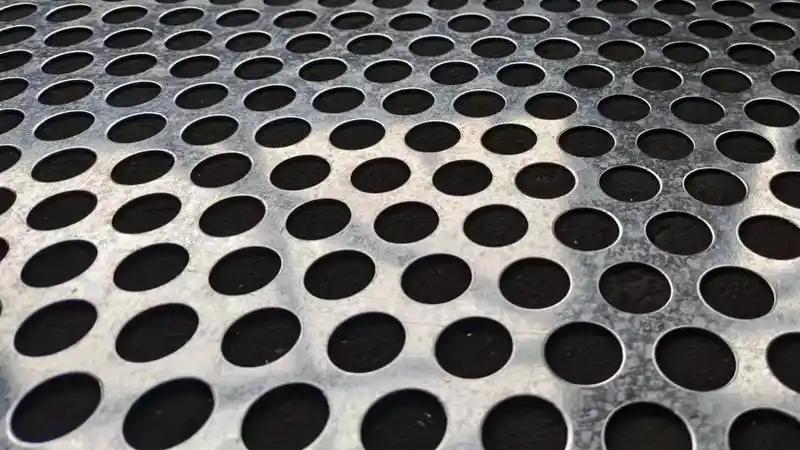Which Is Better: Patterned Galvanized Perforated Steel Plate or Plain Galvanized Perforated Steel Plate?
Source:www.cn-psp.cnAuthor:河北森驰公司 Last updated:2025-04-25 13:59:34 Browse:
In the field of metal perforated plates, galvanized perforated steel plates are widely used in building façades, interior decoration, filtration and sieving, and ventilation, thanks to their excellent corrosion resistance and outstanding durability. When procuring these panels, customers are often torn between the surface effects of “patterned galvanized perforated steel plate” and “plain galvanized perforated steel plate.” This article delves into their technical principles, performance differences, typical applications, and purchasing suggestions to help you make an informed choice.
2. Formation and Characteristics of Patterned Galvanized Perforated Steel Plate
The “pattern” (spangle) on a patterned galvanized perforated steel plate is a unique crystalline motif formed during the hot-dip galvanizing process as the zinc bath cools naturally.
Formation Mechanism: After hot-dip galvanizing, residual molten zinc on the steel surface cools slowly at ambient temperature. Zinc crystals grow in preferred orientations, creating visible hexagonal or circular patterns.
Visual Effect: The result is a natural, layered appearance that complements industrial-style interiors and exteriors. You’ll often see this on traditional corrugated roofs and galvanized pails.
3. Process and Advantages of Plain Galvanized Perforated Steel Plate
Plain galvanized perforated steel plate achieves a smooth, uniform surface by optimizing the production process to suppress or eliminate crystalline patterning.
Key Techniques:
Zinc bath composition control: Adjusting alloying elements like lead and aluminum to inhibit excessive zinc grain growth.
Rapid cooling treatment: Accelerating zinc solidification to prevent large crystal formation.
Post-treatment technologies: Spraying ultra-fine zinc powder or adding grain refiners for a flatter finish.
Surface Effect: A smooth, delicate texture that enhances paint, powder coating, and screen-printing adhesion—ideal for high-end decorative projects demanding modern simplicity.

Galvanized Steel Perforated Sheet
4. Performance and Cost Comparison
Corrosion Resistance & Durability: Both patterned and plain galvanized perforated steel plates use the same zinc coating thickness (e.g., G60, G90, or higher), offering comparable rust protection and service life—typically over 20 years.
Appearance & Decorative Impact:
Patterned plate: Showcases natural crystalline patterns with distinct industrial charm.
Plain plate: Delivers a sleek, polished look suited to minimalist or colorful coating designs.
Coating Adhesion & Secondary Processing:
Plain plate: Uniform surface boosts coating adhesion; can be directly painted or powder-coated.
Patterned plate: Best primed first to ensure long-lasting paint or coating adhesion.
Manufacturing Cost & Total Expense:
Plain plates incur slightly higher production costs due to additional pattern-control and post-treatment steps.
However, savings on secondary coatings and maintenance often offset the upfront price difference, yielding superior overall value.
5. Typical Applications
Building Façades & Exterior Cladding: Plain galvanized perforated steel plate is preferred for its even surface, which accommodates diverse colors and patterns.
Interior Decoration & Partitioning: High-end hotels and office towers benefit from plain plates; patterned plates suit industrial-style or vintage-themed spaces.
Filtration, Sieving & Ventilation Systems: Functionality is key—both types perform equally, but patterned plates may offer better cost efficiency.
Landscape Architecture & Municipal Facilities: Selection depends on design themes; both patterned and plain galvanized perforated steel plates provide reliable strength and corrosion protection.
6. Professional Purchasing & Maintenance Suggestions
Clarify Project Requirements: Determine whether aesthetics, functionality, or a blend of both is paramount, then choose between patterned or plain galvanized perforated steel plate accordingly.
Check Zinc Coating Grade: Select the appropriate zinc thickness (e.g., G90 or above) based on installation conditions—indoor, outdoor, coastal, or high-humidity environments.
Inspect Surface Quality: For patterned plates, ensure even, natural spangle; for plain plates, verify flatness and readiness for post-coating.
Regular Maintenance: Clean surfaces with neutral detergents; avoid strong acids or alkalis to slow aging and corrosion.
7. Conclusion
Overall, patterned and plain galvanized perforated steel plates offer identical corrosion resistance and durability. The key differences lie in appearance and cost structure. Clients should flexibly choose the product that best matches their project’s aesthetic goals, secondary coating needs, and budget—ensuring quality and maximizing value.
